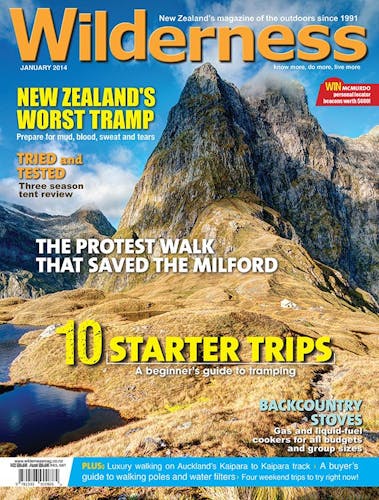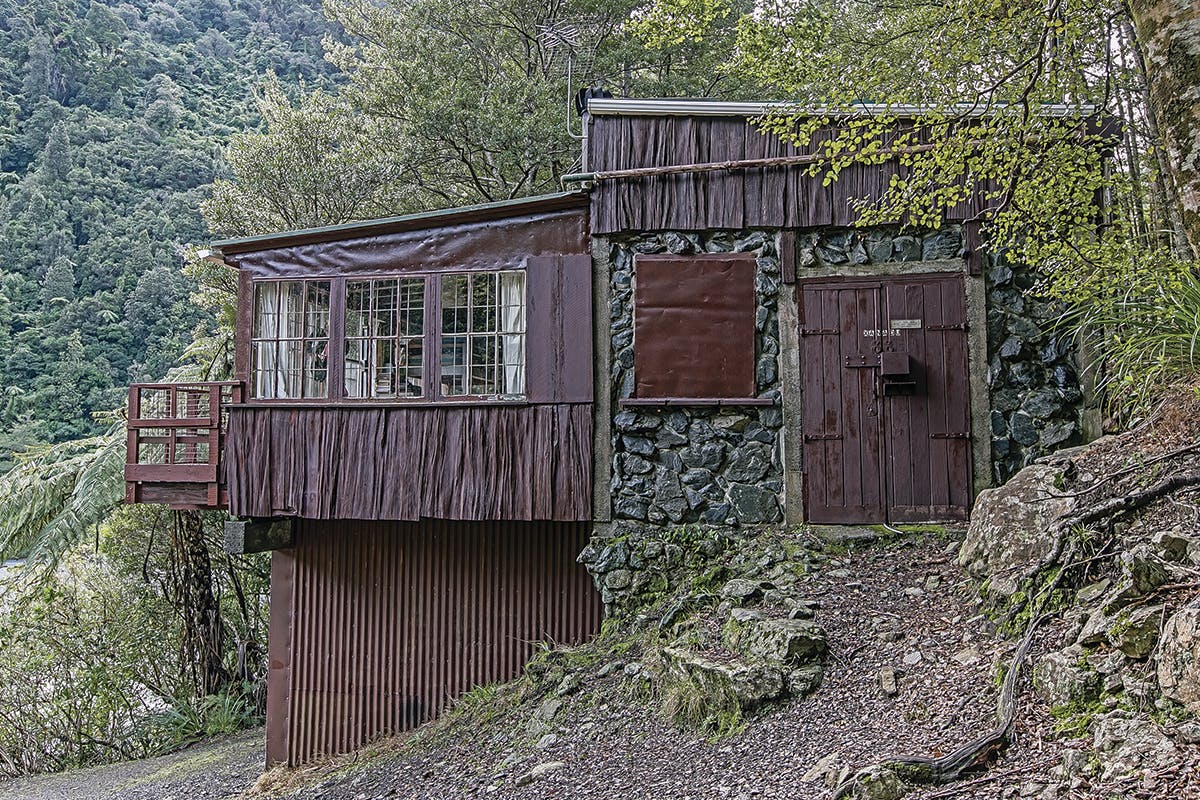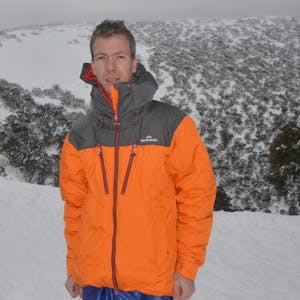A quirk of history has seen dozens of private huts built in the Orongorongo Valley in Rimutaka Forest Park. Ricky French examines what will happen when occupancy licences expire in 2050
There’s something quite strange about opening the door to a bush hut in New Zealand and knowing it’s yours exclusively for the night.
Booking a hut is usually something that only happens when venturing into Great Walk huts in peak season, but even then you are only guaranteed a sleeping spot, not run of the roost. We are taught to make late-comers welcome and not spread our gear everywhere; to be aware that huts are shared spaces where strangers huddle under one roof.
But there’s a pocket of bush near Wellington where this doesn’t happen.
There’s a place where you can spill an array of luxury items from your pack onto the floor and settle into your private holiday house for a night or two, knowing that no unknown clomps at the door will be heard as you’re preparing dinner, or stacking the furniture for a game of hut-cricket. The walk in is easy; an undulating stroll of not much more than an hour. Think of it as a reward for all the long ordeals you’ve endured in the bush, or think of it as a gentle introduction to tramping for children or outdoor novices; free of hardships, taking the good with the good. It’s tramping, but not as we know it. It’s tramping Orongorongo-style. But amongst the ferns, the beeches, the huts and the river rocks a grand stoush is brewing.
The Orongorongos, as the area inside Rimutaka Forest Park over the eastern hills of Wellington is commonly known, remains one of the only areas in New Zealand offering sole-occupancy of Department of Conservation huts. It’s an area popular with the public, and especially school groups, and the department has spent a large amount of money recently constructing three new huts.
Herb Christophers from DOC says the risk of vandalism, due to the easy access, is one reason DOC decided to make the huts sole-occupancy. Tradition is another. “The Orongorongo huts were always locked, except Baine-iti,” he says. “As the Forestry Service, and then DOC, took them over, this tradition remained and allowed for a different experience from the usual regime.”
DOC operates six huts in the Orongorongo Valley as sole-occupancy, but this is only a small fraction of the huts that are standing on the land. You won’t spot them from the river bed, but nestled amongst the bush are at least another 50. The doors are locked and no one is handing out a key. Most visitors would never know they exist, let alone set a muddy foot inside. They are all privately owned, and their future is currently hinging on a tussle between DOC and their owners that could culminate in nearly all being demolished.
There have been huts in the Orongorongo Valley since the 1910s, with one of the earliest huts, Baine-iti, still standing. Wellingtonians flocked to the nearby, secluded valley to build huts for recreation or weekend getaways, or even as cheap long-term accommodation during the depression. Tramping clubs also got in on the action and by the 1970s there were more than 70 huts clustered upon the river, at which point the building of further huts was curtailed by the water board. Times were changing for the private hut owners as the New Zealand Forestry Service, and later DOC, tightened their grip. In 1988, DOC increased licensing fees for the huts and insisted the private huts meet fire regulations and safety standards. DOC felt compelled to do this because the huts fell on conservation land. Red tape started to tie up time and resources. Put simply, the privately owned huts were a niggle that DOC would rather be rid of.
In the late 1990s, DOC formalised its current policy. All privately owned huts on public conservation land in the Orongorongo Valley would have occupancy licences until 2050 or the death of the current owner. No other people could be added to the licence, ownership could not be transferred and no hut could be sold. Christophers says it’s the responsibility of the licensee to remove the hut once the term expires, and they are welcome to dismantle the hut and rebuild it on private land. If the hut is not removed though, it appears unlikely to live out its days in the Orongorongos.
“There is no need for any further publicly available accommodation in the Orongorongo Valley and any decision about the fate of huts not removed by the owner would be made on a case by case basis,” says Christophers.
But the hut owners believe they have a weapon up their sleeve: history. The private huts are now undoubtably an integral part of the valley’s history and heritage, and part of DOC’s legislative role is to preserve this. It’s a point not lost on the hut owners, who in 1978 formed a coalition called the Orongorongo Club, to present a cohesive voice and lobby their position. The club quickly set about recording the valley’s history, with a focus on the huts and the people who built them. With this historical record the club hopes to influence DOC into changing its policies and allowing the huts to remain in private ownership.
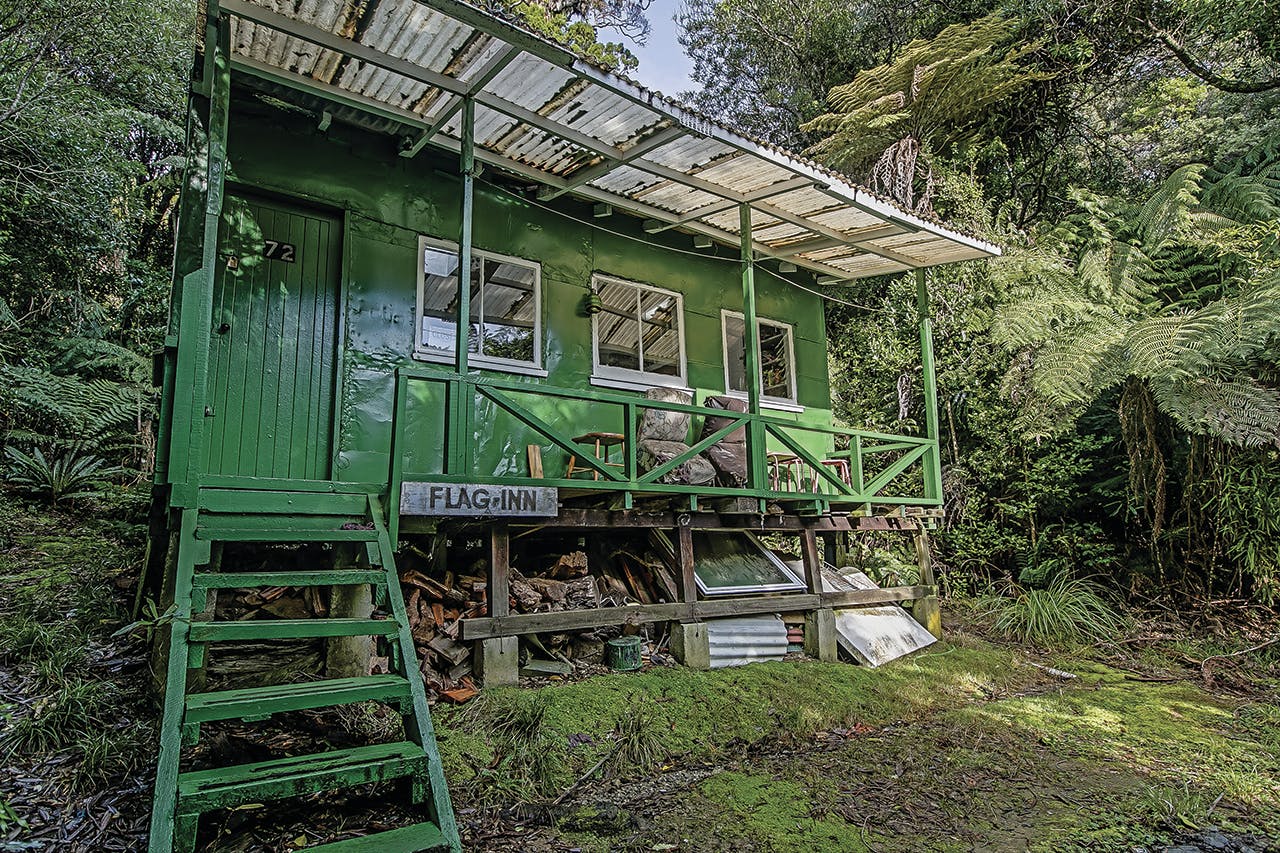
Flag Inn. Photo: Supplied
Ian Hutchings from the Orongorongo Club says the club has recently spent just under $30,000 on a historical study of all structures in the valley, including a detailed look at every hut. It is due to be published in the coming months. Hutchings hopes the study, which he says uses Historic Places Trust criteria, will “make others aware of the heritage values and lead to some form of protection”.
Christophers, though, is doubtful any claim to the Historic Places Trust would be successful: “Most of the huts were built in the late 1960s or early 1970s, so in 2050 they would be 80 years old. Their value is to reflect a social history rather than being physical examples that have merit to warrant legal protection. Under current historic legislation these would not meet criteria for retention in situ.”
According to Hutchings, the issue is not primarily about the huts, it’s about “wanting to promote the qualities of the valley for recreation, conservation and protection for future generations”. He says the privately owned huts are merely a way in which to facilitate these values for a large number of people: “We see the huts as a means to an end. The use by owners, and their family and friends gives opportunities to enjoy the valley in safety and comfort, and in far greater numbers than is possible under the DOC hut systems. In essence, DOC is belatedly trying to replicate the sorts of benefits that the private huts have been providing to the wider community for many, many decades.”
The huts, he adds, were on the land long before it became acquired by DOC, and never had any detrimental effects. “It is simply ideology that private huts on public land should be removed.”
Christophers claims DOC is enforcing the law under the Conservation Act 1987, which states that all private accommodation facilities must be phased out, except if concessions are made in any relevant Conservation Management Strategy (CMS) or plan. As it stands most regions’ CMS provides little wriggle room for private dwellings on public land, but it could be the only door ajar for the Orongorongo Club. Hutchings points out inconsistencies in policies, in particular the existence of private club huts on Mt Ruapehu, which he says effectively have perpetual use arrangements. Elsewhere in the country, other private huts have been granted a stay of execution, with compromises made. “The West Coast CMS review has left some private huts in place, with a recognition and requirement for greater public use,” says Hutchings.
During the winter of 2012, Alan Sheppard, along with his wife Glennis, embarked on an ambitious task. Armed with a Cannon 5D Mark III camera, the pair set off on a 120km ramble through the Orongorongos, with the goal of photographing every hut in the valley. The results were recently published in the 84 page hardback book Huts of the Orongorongo Valley. Sheppard says he was unaware of the Orongorongo Club’s heritage study when he set out, but now plans to use many of his photos to help the club in its quest to save the private huts.
Of the mission to locate and photograph the huts, Sheppard says locating access tracks proved to be the most difficult part. “The hardest hut to find took three attempts and was finally found on a high level track which had a windfall between the hut and the track which diverted us away from the hut at the critical moment,” he says. “We finally tracked it down using high resolution photography.”
The project took Alan and Glennis three day-trips and two overnight stays, often bush-bashing, clambering up banks and sloshing through the freezing river. The result is a beautiful photographic record of the huts – one that documents them in all their wacky and dishevelled glory. Imaginations have gone bush in the construction of many of the huts, and each is unique, wonderful and unlikely. Sheppard initially photographed the huts in preparation for Taihoa’s 50th birthday celebrations.
‘Taihoa’ is the name of a privately owned hut that Sheppard has been involved with since its early days, and its history illustrates many of the arguments Orongorongo Club members are making.
In 1962 a teacher at Onslow College named Gwenda Martin took two of her students for a tramp into the Orongorongos to look for a site to build a hut. They chose a spot and put in an application to the water board. The trio built the hut from timber cut from the area, mostly kahikatea, and by the end of summer in 1963 Taihoa was complete. One of those students was Philip Porritt. He remembers that summer clearly: “There was word around town that a teacher and a couple of kids were building a hut upstream, and that it wouldn’t last six months,” he recalls. “Well, it’s just had its 50th birthday.”
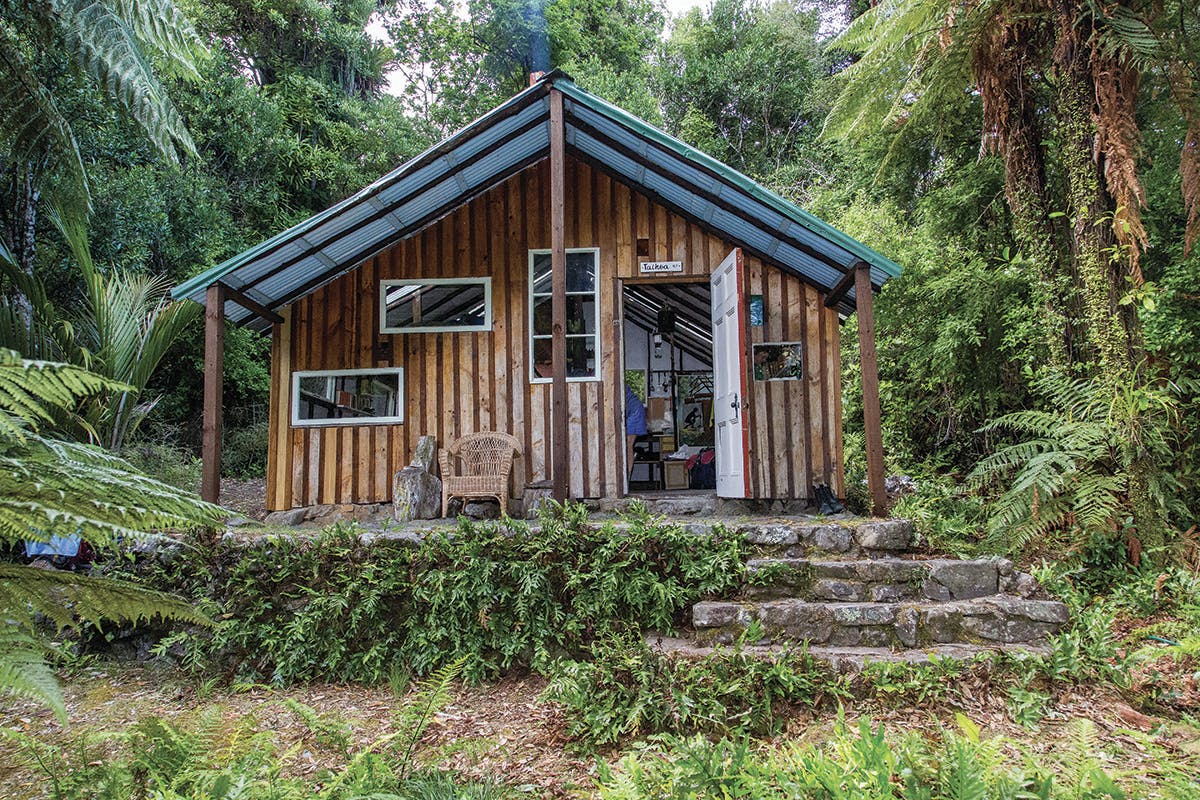
Taihoa Hut is more than 50 years old. Photo: Supplied
They celebrated in style. Dress-up costumes included tramping boots and gaiters, Swandries and scroggin, as 60 people hoofed it over the Five Mile Track to present a cake to the hut. A spread rarely seen in the bush was laid out on trestle tables under the ferns and a jubilee birthday cake was unveiled. Those present included family and friends of the original builders, people who had been coming to Taihoa for years, and new generations. One photograph of the party is particularly moving, and shows 86 year-old Martin unlocking the door to her hut, 50 years after she hammered the first nail.
Porritt says the hut has bonded people to the outdoors, and to each other: “It’s been a link for a whole group of people to remain in contact, which has been great.”
Parties are fantastic, but what about the day to day running of your own bush hut in the Orongorongos? “DOC inspects the huts every two years, to see the condition of the hut and check that people aren’t chopping down trees or leaving rubbish,” says Porritt.
Maintenance and upkeep of the huts is ongoing work. Last summer Porritt put in a solar system for lights, but he says most of the original owners of the huts are aging and the physical demands of maintaining a hut are taxing. He says there is now a whole group of people who are chipping in to keep Taihoa going. “We now have about six people who each put $10 a month into Taihoa’s bank account, just to make sure there’s money to keep it maintained and pay the licence,” he says.
The licence fee now stands at $630 a year. Regulations and fees aren’t the only thing eating away at the hut. “Taihoa is suffering from borer,” says Porritt. “Unfortunately they just love kahikatea. It could be borer which eventually leads to the demise of the hut, not DOC. But with the recent work that’s been done, at least the immediate future for Taihoa is looking bright. There’s a good group of people who are all chipping in, it’s really nice to see.”
Porritt believes at the heart of DOC’s anti-private hut stance is private benefit on public land. “Basically, DOC’s issue is they don’t want private people benefiting from public amenities. It’s a similar situation with the huts on Rangitoto Island,” he says. “There are pockets of private huts on public land all around the country.”
The difference may partly be the high concentration of huts in the Orongorongo Valley: higher than anywhere else in New Zealand, all with different sets of owners, some whose recreation values perhaps aren’t as wholesome as Porritt’s.
“Some of the hut owners here are petrol heads, whose big thrill is driving up the river and making noise,” he admits.
DOC has strict rules governing when vehicular access is allowed, but it’s a sad fact that any hut in the bush which is accessible by vehicle is prone to the boorish behaviour of rev-heads. These sort of hut owners damage the brand that the Orongorongo Club is promoting, and certainly do no favours in the push to keep the leases.
DOC is so far refusing to budge on its stance. It doesn’t want private huts on public land, and it believes it is already being generous by allowing leases to be maintained for the life of the current owners. Porritt believes most of the current owners are in their late 60s. There is little chance that the cut-off year of 2050 will ever be seen by any of them under the current laws.
It is easy to sympathise with the hut-owners. Many of these huts have been witness to generations of families. No family deserves to have its home taken, even if it is a holiday home. But at the same time there needs to be some control. No one would want to see the huts bought and sold at auction, extensions and spa pools built, legal battles played out over planning issues. Private enterprise in a conservation area can bring out the worst in people, and that has no place in the bush, where egalitarian values and a common spirit have always out-trumped padlocks and private real estate.
What if Porritt’s wish for Taihoa to remain with his family is unsuccessful? “Well, I’ll be dead,” he notes. “But my sons would like to think it would stay there, and it’s possible that DOC’s conditions could be renegotiated.
“Hopefully my sons will take up that fight; it would be nice for the hut to stand as a monument once I’m dead.”
In the meantime, Porritt intends to continue strolling down the venerable Five-Mile Track with his family and friends, wading through the Orongorongo River, pushing through a secret gap in the trees as he’s done for the last 50 years and slowly opening the creaking door of Taihoa, his very own bush hut.





